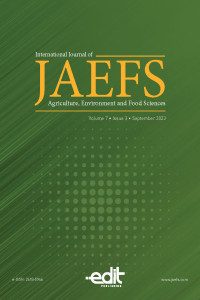Anatomical observations on formation and development of adventitious root primordium in canes of Vitis sp.
Öz
Understanding the anatomical aspects of adventitious root primordium formation can provide valuable insights into the improvement of propagation techniques, rootstock selection, and overall vineyard management practices in Vitis spp. This work was carried out to investigate anatomical root primordium formation in the rooted cuttings of Cabernet Sauvignon (CS, Vitis vinifera L.) and the rootstock Kober 5BB (Vitis berlandieri x V. riparia) with their relationship to stem anatomy. One-node cuttings were grown under temperature-controlled conditions for 8 weeks. After removal of the roots and calli, the stem parts were fixed in a fixative solution. A revised method of safranin staining was applied to the 90 µm thick cross-sections made with a hand microtome. It was observed that root primordia were derived from the two different regions of the cane tissues: from the groups of cells close to the outside of the conductive tissue system and from the cell groups in the deeper site, close to the pith. Cultivars showed significant differences in terms of the regions where they had their root primordial initials. Number of potential root primordia was statistically higher in CS. Both CS and 5BB had root angles in the range of 83° to 86°. It was concluded that grapevine cuttings had only induced root primordia and the capacity to produce them was dependent on the genotype. Formation and development of root primordia and the anatomical differentiation of the cell groups were similar in Cabernet Sauvignon and 5BB.
Anahtar Kelimeler
Kaynakça
- Ali, M.L., Luetchens, J., Nascimento, J., Shaver, T.M., Kruger, G.R., Lorenz, A.J. (2015). Genetic variation in seminal and nodal root angle and their association with grain yield of maize under water-stressed field conditions. Plant Soil 397, 213-225. https://doi.org/10.1007/s11104-015-2554-x
- Beakbane, A.B. (1961). Structure of the plant stem in relation to adventitious rooting. Nature, 192, 954-955. https://doi.org/10.1038/192954a0
- Bond, J., Donaldson, L., Hill, S., Hitchcock, K. (2008). Safranine fluorescent staining of wood cell walls. Biotech. Histochem. 83(3-4), 161-171. https://doi.org/10.1080/10520290802373354
- Cameron, R.J., Thomson, GV. (1969). The vegetative propagation of Pinus radiata: root initiation in cuttings. Botanical Gazette 130, 242-251.
- Dathe, A., Postma, J.A., Postmablaauw, M.B., Lynch, J.P. (2016). Impact of axial root growth angles on nitrogen acquisition in maize depends on environmental conditions. Ann. Bot. 118, 401-414. https://doi.org/10.1093/aob/mcw112
- Dumont, C., Cochetel, N., Lauvergeat V, Cookson, S.J., Ollat, N., Vivin, P. (2016). Screening root morphology in grafted grapevine using 2D digital images from rhizotrons. Acta Hortic. 1136, 213-220 https://doi.org/10.17660/ActaHortic.2016.1136.29
- Fujii T. (1955). Origin and development of root primordia in grape cuttings. Journal of the Japanese Sociesty of Horticultural Science 24(3): 160-164.
- Hacke, U. (2015). Functional and ecological xylem anatomy. Springer International Publishing Switzerland. 133.
- Hackett, W.P. (1988). Donor plant maturation and adventitious root formation, p. 11-28. In: T.D. Davis, B.E. Haissig, and N. Sankhla (eds.). Adventitious root formation in cuttings, Dioscorides, Portland, Ore.
- Han Q-Q. (1983). The primary observation on anatomy of the adventitious root formation in grape cuttings. Journal of the Agricultural university of Hebei 45-48.
- Hayward, H.E. (1983). The Structure of economic plants, Mcmillan, New York, pp. 39-56.
- Hicks, G. S. (1987). Adventitious rooting of apple microcuttings in vitro: An anatomical study. Can. J. Bot. 65, 1913-1920. https://doi.org/10.1139/b87-262
- Isfendiyaroğlu, M., Ozeker, E. (2008). Rooting of Olea europaea ‘Domat’ cuttings by auxin and salicylic acid treatments. Pakistan Journal of Botany, vol. 40, no. 3, pp. 1135–1141.
- Kato, Y., Abe, J., Kamoshita, A., Yamagishi, J. (2006). Genotypic variation in root growth angle in rice (Oryza sativa L.) and its association with deep root development in upland fields with different water regimes. Plant Soil. 287, 117-129. https://doi.org/10.1007/s11104-006-9008-4
- Kitomi, Y., Kanno, N., Kawai, S., Mizubayashi, T., Fukuoka, S., Uga, Y. (2015). QTL underlying natural variation of root growth angle among rice cultivars with the same functional allele of DEEPER ROOTING 1. Rice (N Y) 8, 1-12. https://doi.org/10.1186/s12284-015-0049-2
- Koll, K., Zelko, I., Henselov, M., Capek, P., Liskov, D. (2012). Growth and anatomical parameters of adventitious roots formed on mung bean hypocotyls are correlated with galactoglucomannan oligosaccharides structure. The Scientific World Journal, 797815, 7. https://doi.org/10.1100/2012/797815
- Lovell, H.L., White, J. (1986). Anatomical changes during adventitious root formation, p. 111-140. In: M.B. Jackson (ed.). New root formation in plants and cuttings. Martinus Nijhoff, Dodrecht, Netherlands.
- Ramalingam, P., Kamoshita, A., Deshmukh, V., Yaginuma, S., Uga, Y. (2017). Association between root growth angle and root length density of a near isogenic line of IR64 rice with Deeper Rooting 1 under different levels of soil compaction. Plant Production Science, 20 (2), 162-175. https://doi.org/10.1080/1343943X.2017.1288550
- Ranjit, M., Kester, D.E., Polito, V.S. (1988). Micropropagation of cherry rootstocks: III. Correlations between anatomical and physiological parameters and root initiation. J. Amer. Soc. Hort. Sci. 113(1), 155-159.
- Roy, C.R., Carlson, R.F., Audergon, J.M. (1987). Rootstocks for fruit crops. A willey interscience publication. New York.
- Samartin, A., Vieitez, A.M. and Vieitez, E. (1986). Rooting of tissue cultured camellias. J. Hort. Sci. 61, 113-120. https://doi.org/10.1080/14620316.1986.11515680
- Schmitz, R, Atkinson, B.S., Turrock, C.J.S., Hausmann, L., Töpfer, R., Herzog, K. (2021). High-resolution 3D phenotyping of the grapevine root system using X-ray computed tomography. Vitis 60, 21–27 (2021) https://doi.org/10.5073/vitis.2021.60.21-27
- Smart, D.R., Kocsis, L., Walker, M.A., Stockart, C. (2003). Dormant buds and adventitious root formation by vitis and other woody plants. J Plant Growth Regul. 21: 296-314. https://doi.org/10.1007/s00344-003-0001-3
- Tailor, A., Kumari, A., Gogna, M., Mehta, S. (2022). Revisiting the anatomical changes during adventitious root formation in cuttings. In A. Husen (ed.), Plant Biology, Sustainability and Climate Change, Environmental, Physiological and Chemical Controls of Adventitious Rooting in Cuttings, Academic Press, pp 101-132. https://doi.org/10.1016/B978-0-323-90636-4.00022-2
- Uga, Y., Kitomi, Y., Ishikawa, S., Yano, M. (2015). Genetic improvement for root growth angle to enhance crop production. Breed. Sci. 65(2), 111-119. https://doi.org/10.1270/jsbbs.65.111
- Van der Lek, H. A. A. (1925). Root development in woody cuttings. Mededelingen Landbouwhogeschool Wageningen, 28, 211-230.
- Vieitez, A. M., Vieitez, M. L. (1983). Secuencia de cambios anatomicos durante la rizogenesis in vitro del castano. Phyton 43, 185-191.
Öz
Destekleyen Kurum
yok
Kaynakça
- Ali, M.L., Luetchens, J., Nascimento, J., Shaver, T.M., Kruger, G.R., Lorenz, A.J. (2015). Genetic variation in seminal and nodal root angle and their association with grain yield of maize under water-stressed field conditions. Plant Soil 397, 213-225. https://doi.org/10.1007/s11104-015-2554-x
- Beakbane, A.B. (1961). Structure of the plant stem in relation to adventitious rooting. Nature, 192, 954-955. https://doi.org/10.1038/192954a0
- Bond, J., Donaldson, L., Hill, S., Hitchcock, K. (2008). Safranine fluorescent staining of wood cell walls. Biotech. Histochem. 83(3-4), 161-171. https://doi.org/10.1080/10520290802373354
- Cameron, R.J., Thomson, GV. (1969). The vegetative propagation of Pinus radiata: root initiation in cuttings. Botanical Gazette 130, 242-251.
- Dathe, A., Postma, J.A., Postmablaauw, M.B., Lynch, J.P. (2016). Impact of axial root growth angles on nitrogen acquisition in maize depends on environmental conditions. Ann. Bot. 118, 401-414. https://doi.org/10.1093/aob/mcw112
- Dumont, C., Cochetel, N., Lauvergeat V, Cookson, S.J., Ollat, N., Vivin, P. (2016). Screening root morphology in grafted grapevine using 2D digital images from rhizotrons. Acta Hortic. 1136, 213-220 https://doi.org/10.17660/ActaHortic.2016.1136.29
- Fujii T. (1955). Origin and development of root primordia in grape cuttings. Journal of the Japanese Sociesty of Horticultural Science 24(3): 160-164.
- Hacke, U. (2015). Functional and ecological xylem anatomy. Springer International Publishing Switzerland. 133.
- Hackett, W.P. (1988). Donor plant maturation and adventitious root formation, p. 11-28. In: T.D. Davis, B.E. Haissig, and N. Sankhla (eds.). Adventitious root formation in cuttings, Dioscorides, Portland, Ore.
- Han Q-Q. (1983). The primary observation on anatomy of the adventitious root formation in grape cuttings. Journal of the Agricultural university of Hebei 45-48.
- Hayward, H.E. (1983). The Structure of economic plants, Mcmillan, New York, pp. 39-56.
- Hicks, G. S. (1987). Adventitious rooting of apple microcuttings in vitro: An anatomical study. Can. J. Bot. 65, 1913-1920. https://doi.org/10.1139/b87-262
- Isfendiyaroğlu, M., Ozeker, E. (2008). Rooting of Olea europaea ‘Domat’ cuttings by auxin and salicylic acid treatments. Pakistan Journal of Botany, vol. 40, no. 3, pp. 1135–1141.
- Kato, Y., Abe, J., Kamoshita, A., Yamagishi, J. (2006). Genotypic variation in root growth angle in rice (Oryza sativa L.) and its association with deep root development in upland fields with different water regimes. Plant Soil. 287, 117-129. https://doi.org/10.1007/s11104-006-9008-4
- Kitomi, Y., Kanno, N., Kawai, S., Mizubayashi, T., Fukuoka, S., Uga, Y. (2015). QTL underlying natural variation of root growth angle among rice cultivars with the same functional allele of DEEPER ROOTING 1. Rice (N Y) 8, 1-12. https://doi.org/10.1186/s12284-015-0049-2
- Koll, K., Zelko, I., Henselov, M., Capek, P., Liskov, D. (2012). Growth and anatomical parameters of adventitious roots formed on mung bean hypocotyls are correlated with galactoglucomannan oligosaccharides structure. The Scientific World Journal, 797815, 7. https://doi.org/10.1100/2012/797815
- Lovell, H.L., White, J. (1986). Anatomical changes during adventitious root formation, p. 111-140. In: M.B. Jackson (ed.). New root formation in plants and cuttings. Martinus Nijhoff, Dodrecht, Netherlands.
- Ramalingam, P., Kamoshita, A., Deshmukh, V., Yaginuma, S., Uga, Y. (2017). Association between root growth angle and root length density of a near isogenic line of IR64 rice with Deeper Rooting 1 under different levels of soil compaction. Plant Production Science, 20 (2), 162-175. https://doi.org/10.1080/1343943X.2017.1288550
- Ranjit, M., Kester, D.E., Polito, V.S. (1988). Micropropagation of cherry rootstocks: III. Correlations between anatomical and physiological parameters and root initiation. J. Amer. Soc. Hort. Sci. 113(1), 155-159.
- Roy, C.R., Carlson, R.F., Audergon, J.M. (1987). Rootstocks for fruit crops. A willey interscience publication. New York.
- Samartin, A., Vieitez, A.M. and Vieitez, E. (1986). Rooting of tissue cultured camellias. J. Hort. Sci. 61, 113-120. https://doi.org/10.1080/14620316.1986.11515680
- Schmitz, R, Atkinson, B.S., Turrock, C.J.S., Hausmann, L., Töpfer, R., Herzog, K. (2021). High-resolution 3D phenotyping of the grapevine root system using X-ray computed tomography. Vitis 60, 21–27 (2021) https://doi.org/10.5073/vitis.2021.60.21-27
- Smart, D.R., Kocsis, L., Walker, M.A., Stockart, C. (2003). Dormant buds and adventitious root formation by vitis and other woody plants. J Plant Growth Regul. 21: 296-314. https://doi.org/10.1007/s00344-003-0001-3
- Tailor, A., Kumari, A., Gogna, M., Mehta, S. (2022). Revisiting the anatomical changes during adventitious root formation in cuttings. In A. Husen (ed.), Plant Biology, Sustainability and Climate Change, Environmental, Physiological and Chemical Controls of Adventitious Rooting in Cuttings, Academic Press, pp 101-132. https://doi.org/10.1016/B978-0-323-90636-4.00022-2
- Uga, Y., Kitomi, Y., Ishikawa, S., Yano, M. (2015). Genetic improvement for root growth angle to enhance crop production. Breed. Sci. 65(2), 111-119. https://doi.org/10.1270/jsbbs.65.111
- Van der Lek, H. A. A. (1925). Root development in woody cuttings. Mededelingen Landbouwhogeschool Wageningen, 28, 211-230.
- Vieitez, A. M., Vieitez, M. L. (1983). Secuencia de cambios anatomicos durante la rizogenesis in vitro del castano. Phyton 43, 185-191.
Ayrıntılar
| Birincil Dil | İngilizce |
|---|---|
| Konular | Bahçe Bitkileri Yetiştirme ve Islahı |
| Bölüm | Makaleler |
| Yazarlar | |
| Yayımlanma Tarihi | 30 Eylül 2023 |
| Gönderilme Tarihi | 31 Mayıs 2023 |
| Kabul Tarihi | 23 Ağustos 2023 |
| Yayımlandığı Sayı | Yıl 2023 Cilt: 7 Sayı: 3 |
Kaynak Göster
International Journal of Agriculture, Environment and Food Sciences dergisinin içeriği, Creative Commons Alıntı-GayriTicari (CC BY-NC) 4.0 Uluslararası Lisansı ile yayınlanmaktadır. Söz konusu telif, üçüncü tarafların içeriği uygun şekilde atıf vermek koşuluyla, ticari olmayan amaçlarla paylaşımına ve uyarlamasına izin vermektedir. Yazarlar, International Journal of Agriculture, Environment and Food Sciences dergisinde yayınlanmış çalışmalarının telif hakkını elinde tutar.
Web: dergipark.org.tr/jaefs E-mail: editor@jaefs.com WhatsApp: +90 850 309 59 27



